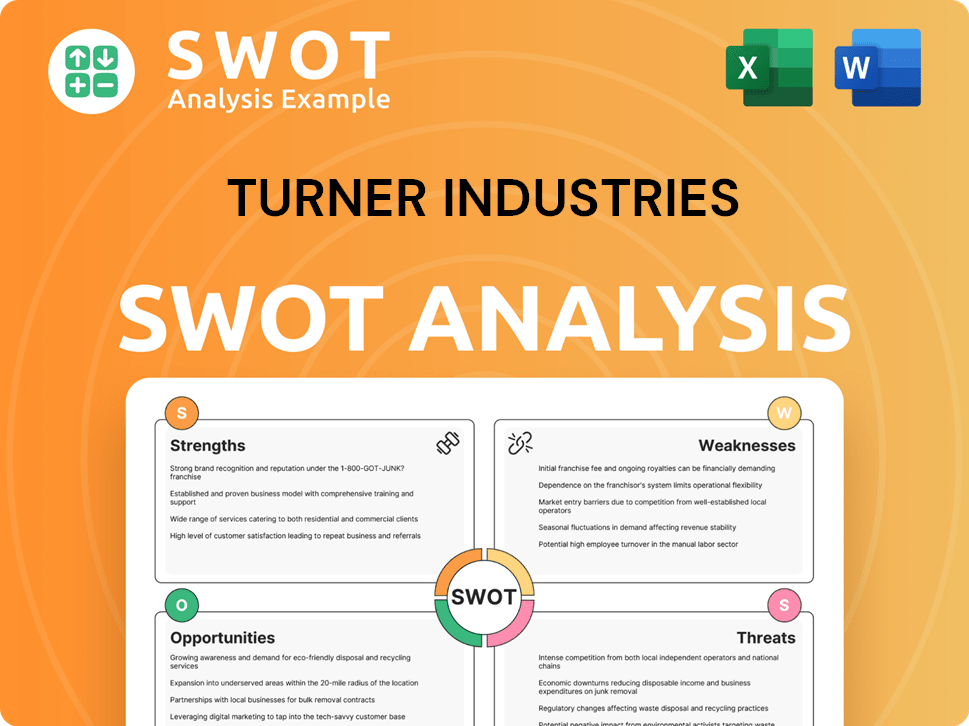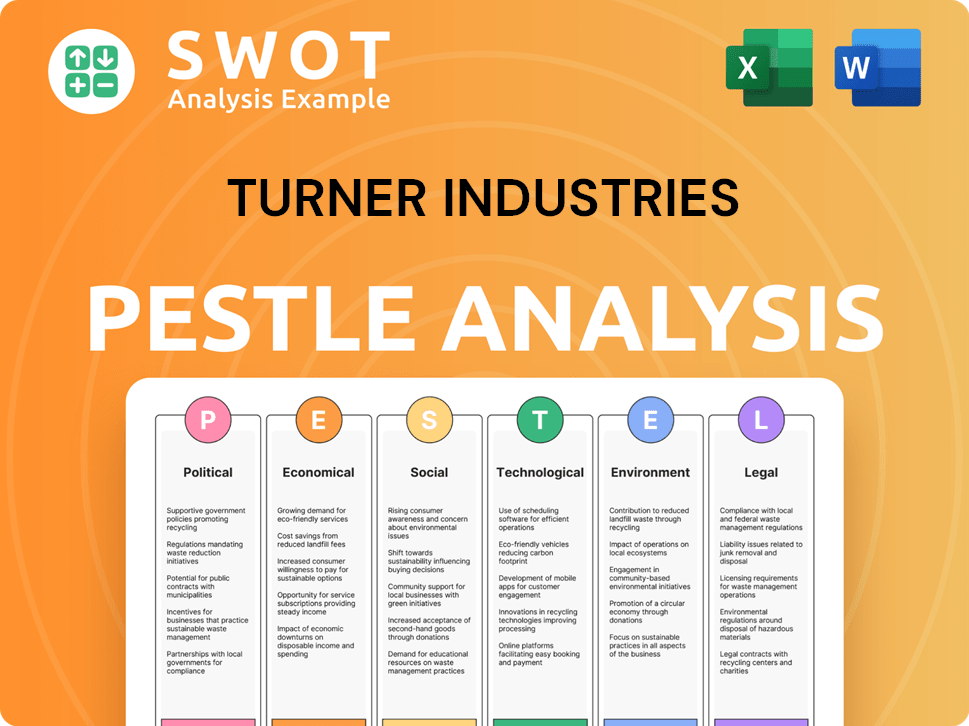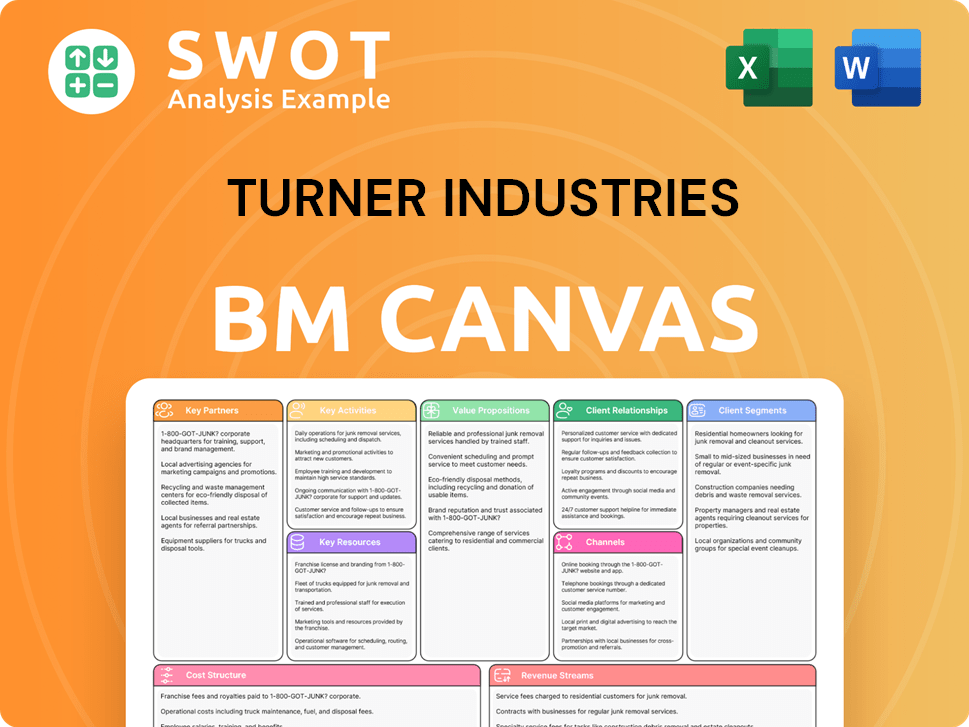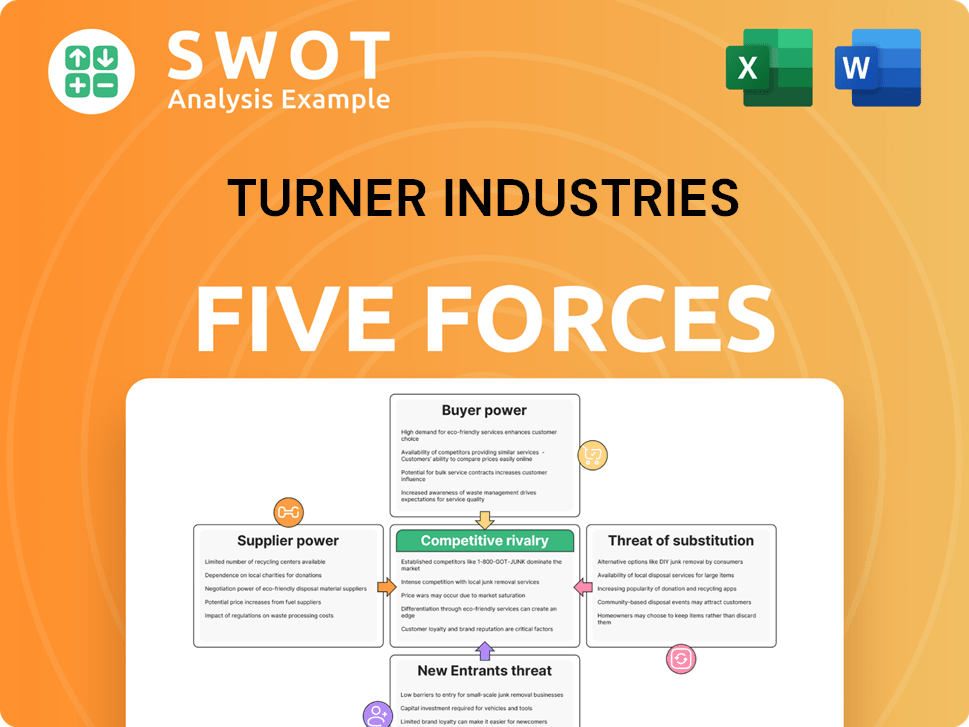Turner Industries Bundle
How Does Turner Industries Stack Up in Today's Industrial Arena?
In the dynamic world of heavy industrial services, understanding the competitive landscape is crucial for making informed decisions. Turner Industries, a leader in construction, maintenance, and fabrication, operates in a complex environment. This analysis dives deep into the Turner Industries SWOT Analysis to uncover its position within the market.

This exploration of the Turner Industries competitive landscape will examine its key rivals and market share analysis. We'll dissect the company's strengths and weaknesses, providing insights into its strategic positioning within the industry. Furthermore, the analysis will explore the company's services and how it navigates the competitive threats and opportunities in its sector, offering a comprehensive Turner Industries company profile.
Where Does Turner Industries’ Stand in the Current Market?
Turner Industries holds a significant market position within the heavy industrial services sector. Its core operations focus on industrial construction, maintenance, and fabrication, primarily serving the Gulf Coast region of the United States. The company offers a comprehensive suite of services, from initial construction to ongoing maintenance, catering to a diverse range of industries including chemical, petrochemical, refining, and power generation.
The company's value proposition centers on providing single-vendor solutions, streamlining project management, and enhancing operational efficiency for its clients. This integrated approach allows them to differentiate themselves in a competitive market. They have built strong, long-standing client relationships, which, along with their extensive project portfolio, indicate a strong presence in the industrial construction, maintenance, and fabrication sectors.
Turner Industries' geographic presence is strategically concentrated in key industrial hubs, particularly across the Gulf South. This focus reflects its commitment to serving regions with high concentrations of heavy industry. The company's ability to adapt its positioning, emphasizing a single-vendor solution model, has been a key differentiator in a competitive market. For a deeper dive into their target customer base, you can read about the Target Market of Turner Industries.
While specific market share figures are not publicly disclosed, Turner Industries consistently ranks among the top contractors in relevant industry publications. The company's substantial revenue, as indicated by its ranking in Engineering News-Record, underscores its significant standing in the industrial contracting landscape. This ranking reflects its robust financial health compared to many industry averages.
Turner Industries serves a diverse range of customer segments, including major players in the chemical, petrochemical, refining, power generation, and pulp and paper industries. Their ability to secure and maintain contracts with these large industrial clients highlights their strong reputation and service capabilities within the sector. The company's focus on these sectors aligns with the concentration of heavy industrial activity in the Gulf Coast region.
As a privately held company, specific financial details aren't publicly available. However, Turner Industries' consistent ranking among the top contractors indicates substantial revenue and robust financial health. Its strong position in large-scale turnaround projects and routine maintenance contracts within the petrochemical and refining sectors suggests a stable and profitable business model.
Turner Industries' competitive advantages include its single-vendor solution model, which streamlines project management and enhances operational efficiency. Their long-standing client relationships and extensive project portfolio also contribute to their strong market position. The company's focus on the Gulf Coast region, a hub for heavy industry, further strengthens its competitive edge.
Turner Industries' market position is robust, particularly in the Gulf Coast region, driven by its comprehensive service offerings and long-standing client relationships. The company's focus on providing integrated solutions and its strategic geographic presence in key industrial hubs contribute to its strong standing within the competitive landscape. This allows them to maintain a strong position in the oil and gas sector.
- Strong presence in industrial construction, maintenance, and fabrication.
- Consistent ranking among top contractors, indicating substantial revenue.
- Focus on single-vendor solutions to enhance operational efficiency.
- Strategic geographic presence in key industrial hubs.
Turner Industries SWOT Analysis
- Complete SWOT Breakdown
- Fully Customizable
- Editable in Excel & Word
- Professional Formatting
- Investor-Ready Format

Who Are the Main Competitors Challenging Turner Industries?
The Turner Industries competitive landscape is shaped by a diverse mix of direct and indirect competitors. These entities vie for market share in the industrial services sector, which includes construction, maintenance, and turnaround services. The competitive dynamics are influenced by factors such as project size, geographic reach, and the specific services offered.
Turner Industries competitors face off in a market where securing large-scale contracts and maintaining a strong safety record are crucial. The competitive environment is also impacted by mergers, acquisitions, and the emergence of new technologies. Understanding the strengths and weaknesses of these rivals is essential for evaluating Turner Industries market analysis and strategic positioning.
Direct competitors offer similar services and compete for the same projects. These companies often have extensive resources and global reach, making them formidable rivals in the industrial services market. They compete on project execution, safety, and pricing.
Fluor Corporation is a major player in the engineering, procurement, construction, and maintenance services sector. Fluor often competes with Turner Industries for large-scale industrial projects. Fluor's extensive resources and international presence make it a significant competitor.
KBR, Inc. provides comprehensive engineering and construction services across various sectors, including energy and chemicals. KBR is a direct competitor, particularly for projects in the industrial and energy sectors. KBR's broad service offerings make it a key rival.
Bilfinger, a European-based company, has a strong presence in industrial services, especially in maintenance and turnarounds. Bilfinger competes with Turner Industries in specific segments, particularly in the maintenance and repair of industrial facilities. Bilfinger's specialization in maintenance makes it a key competitor.
Indirect competition comes from smaller, specialized firms and clients who may perform work in-house. These competitors can offer niche services at competitive prices or reduce the need for external contractors. This includes specialized welding, scaffolding, and specific fabrication capabilities.
Smaller, specialized firms provide niche services such as welding, scaffolding, and fabrication. These firms compete on price and specific expertise. Their targeted services can be a cost-effective alternative.
The industrial services market is characterized by intense competition, with companies vying for multi-year maintenance contracts and large-scale capital projects. Key differentiators include competitive bidding, safety records, and project execution capabilities. The Turner Industries industry is also influenced by mergers and acquisitions.
- Mergers and Acquisitions: Consolidation among engineering and construction firms can create larger, more formidable rivals.
- Technological Advancements: Emerging players using advanced analytics, robotics, and modular construction may disrupt the traditional landscape.
- Market Trends: The oil and gas sector, a significant market for Turner Industries, faces fluctuating demand and pricing pressures.
- Geographic Presence: Companies with a strong geographic presence can gain a competitive advantage in specific regions.
Turner Industries PESTLE Analysis
- Covers All 6 PESTLE Categories
- No Research Needed – Save Hours of Work
- Built by Experts, Trusted by Consultants
- Instant Download, Ready to Use
- 100% Editable, Fully Customizable

What Gives Turner Industries a Competitive Edge Over Its Rivals?
The competitive landscape for Turner Industries is shaped by its unique strengths within the heavy industrial services sector. The company's integrated 'single vendor solution' model, encompassing construction, maintenance, and fabrication, streamlines project management and enhances efficiency. This approach, combined with extensive self-perform capabilities, allows for greater control over project quality and timelines, setting it apart from many competitors. Understanding the Growth Strategy of Turner Industries is crucial to grasping its competitive positioning.
Turner Industries' commitment to safety and its established reputation for reliability are significant competitive advantages. These factors foster strong customer loyalty and repeat business in high-risk industrial environments. The company's strategic geographic footprint, especially along the U.S. Gulf Coast, provides a localized advantage, enabling rapid response and deep understanding of regional market dynamics. The company's continuous investment in training, technology, and operational improvements further solidifies its leadership position.
However, the competitive landscape also presents challenges. Imitation by competitors and industry shifts toward new technologies pose potential threats. Maintaining its competitive edge requires ongoing adaptation and innovation to address these challenges and capitalize on future opportunities within the dynamic industrial services market. The company's ability to adapt to evolving industry demands will be key to its continued success.
The integrated model simplifies project management. It reduces coordination complexities for clients. Clients benefit from a single point of contact.
Turner Industries directly employs a majority of its craft labor. This ensures greater control over project quality. It also enhances safety and schedule adherence.
A strong safety record is a critical factor for clients. It is especially important in high-risk industrial environments. The company consistently promotes its safety performance.
The company has a strong presence in the U.S. Gulf Coast. This provides a localized advantage. It also facilitates talent acquisition and retention.
Turner Industries' competitive advantages include its integrated service model and self-perform capabilities. Its strong safety culture and strategic geographic presence also contribute significantly to its success. These advantages help the company maintain a strong position in the market.
- Integrated Services: Offers a comprehensive suite of services.
- Self-Perform: Manages a large portion of its workforce directly.
- Safety Focus: Prioritizes safety in all operations.
- Geographic Presence: Strong presence in key industrial areas.
Turner Industries Business Model Canvas
- Complete 9-Block Business Model Canvas
- Effortlessly Communicate Your Business Strategy
- Investor-Ready BMC Format
- 100% Editable and Customizable
- Clear and Structured Layout

What Industry Trends Are Reshaping Turner Industries’s Competitive Landscape?
The heavy industrial services sector is undergoing significant shifts, creating both challenges and opportunities for companies like Turner Industries. Understanding the Turner Industries competitive landscape requires a deep dive into these trends, including technological advancements, regulatory changes, and global economic factors. This analysis is crucial for assessing the company's future prospects and strategic positioning within the Turner Industries industry.
The ability to adapt to these changes will be critical for maintaining and enhancing market share. This involves not only responding to immediate pressures but also anticipating future developments. A proactive approach to innovation, workforce development, and strategic partnerships will be essential for long-term success and for navigating the evolving Turner Industries services market.
Technological advancements, such as industrial automation and data analytics, are transforming project management and execution. Regulatory changes related to environmental compliance and worker safety require continuous adaptation. Global economic shifts, including energy price fluctuations and supply chain disruptions, impact investment in industrial projects.
Maintaining a skilled workforce amidst an aging labor force and growing demand is a significant challenge. Increasing pressure to reduce carbon footprints and adopt sustainable practices requires investments in green technologies. Fluctuations in raw material costs and project timelines due to geopolitical instability pose risks.
Emerging markets, particularly those undergoing rapid industrialization, offer growth potential. Product innovations, such as advanced modular construction techniques, could enhance efficiency. Strategic partnerships with technology providers or clients can unlock new revenue streams.
Focus on becoming a technologically integrated service provider to leverage data and automation. Continuous investment in workforce development, adoption of cutting-edge technologies, and diversification into emerging industrial sectors. Strategic alliances and acquisitions to expand service offerings and market reach.
To effectively navigate the Turner Industries competitive landscape, the company must prioritize strategic initiatives. These include technological integration, workforce development, and diversification. For further insights into the company's growth strategies, consider reading the Growth Strategy of Turner Industries. These efforts are crucial for maintaining a strong market position and capitalizing on emerging opportunities within the evolving industrial services sector.
Focus on technological advancements like digital twins and AI-driven scheduling to enhance efficiency and reduce costs. Address workforce challenges through training programs and strategic recruitment to ensure a skilled labor pool. Explore opportunities in emerging markets and new energy infrastructure projects to diversify revenue streams.
- Investment in digital technologies to improve project execution and reduce operational costs.
- Development of comprehensive workforce training programs to address the skills gap and retain talent.
- Strategic expansion into emerging markets and sectors with high growth potential, such as renewable energy.
- Strengthening partnerships with technology providers and clients to offer integrated solutions.
Turner Industries Porter's Five Forces Analysis
- Covers All 5 Competitive Forces in Detail
- Structured for Consultants, Students, and Founders
- 100% Editable in Microsoft Word & Excel
- Instant Digital Download – Use Immediately
- Compatible with Mac & PC – Fully Unlocked

Related Blogs
- What are Mission Vision & Core Values of Turner Industries Company?
- What is Growth Strategy and Future Prospects of Turner Industries Company?
- How Does Turner Industries Company Work?
- What is Sales and Marketing Strategy of Turner Industries Company?
- What is Brief History of Turner Industries Company?
- Who Owns Turner Industries Company?
- What is Customer Demographics and Target Market of Turner Industries Company?
Disclaimer
All information, articles, and product details provided on this website are for general informational and educational purposes only. We do not claim any ownership over, nor do we intend to infringe upon, any trademarks, copyrights, logos, brand names, or other intellectual property mentioned or depicted on this site. Such intellectual property remains the property of its respective owners, and any references here are made solely for identification or informational purposes, without implying any affiliation, endorsement, or partnership.
We make no representations or warranties, express or implied, regarding the accuracy, completeness, or suitability of any content or products presented. Nothing on this website should be construed as legal, tax, investment, financial, medical, or other professional advice. In addition, no part of this site—including articles or product references—constitutes a solicitation, recommendation, endorsement, advertisement, or offer to buy or sell any securities, franchises, or other financial instruments, particularly in jurisdictions where such activity would be unlawful.
All content is of a general nature and may not address the specific circumstances of any individual or entity. It is not a substitute for professional advice or services. Any actions you take based on the information provided here are strictly at your own risk. You accept full responsibility for any decisions or outcomes arising from your use of this website and agree to release us from any liability in connection with your use of, or reliance upon, the content or products found herein.